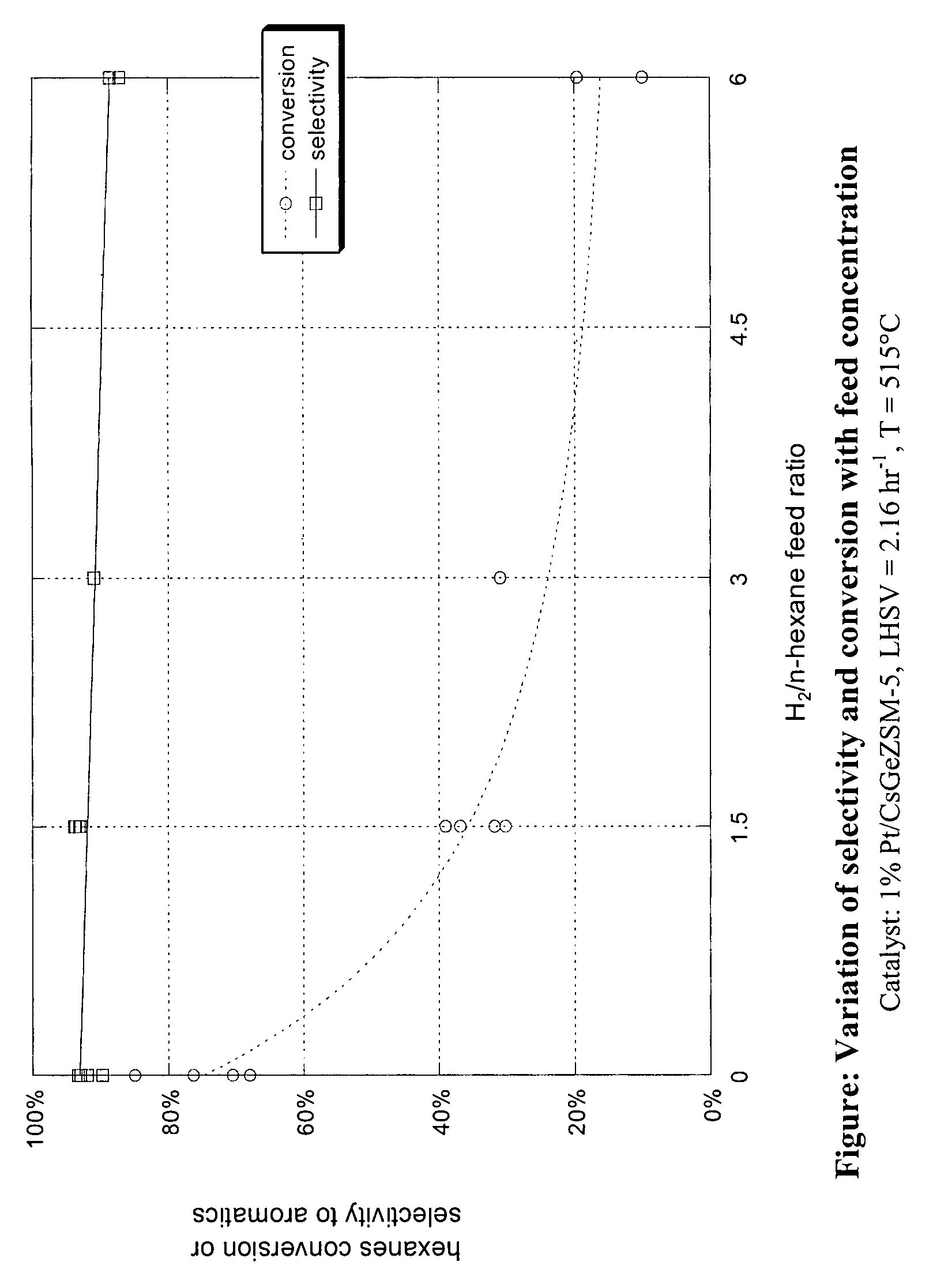Aromatization of alkanes using a germanium-zeolite catalyst
a technology of germanium zeolite and aromatics, which is applied in the field of aromatization of alkanes to aromatics, can solve the problems of catalysts that are extremely sensitive to poisoning, zeolite catalysts are susceptible to sulfur poisoning, and zeolite catalysts contain a group viii deposited metal
- Summary
- Abstract
- Description
- Claims
- Application Information
AI Technical Summary
Benefits of technology
Problems solved by technology
Method used
Image
Examples
example 1
1% Pt / CsGeZSM-5:
[0039]8 grams of GeZSM-5 prepared as described above was washed with 200 ml of aqueous CsNO3 (0.5M) then filtered. The filtrate was then rewashed 3 more times with 0.5M CsNO3 and rinsed with distilled H2O on the final filtering. The zeolite powder was then calcined for 3 hours at 280° C. in air.
[0040]Incipient wetness impregnation was carried out by adding drop wise a solution of 0.069 g Pt(NH2)4(NO3)2 dissolved in 1.343 g of deionized water to 3.508 grams of the Cs-exchanged Ge ZSM-5. The material was dried for 1 hour in a 110° C. drying oven then calcined at 280° C. for 3 hours. Elemental analysis gave 39.92 wt % Si, 0.69 wt % Al, 4.14 wt % Ge, 5.03 wt % Cs, and 0.90 wt % Pt.
[0041]The catalyst powder was pressed and sized to 20-40 mesh. 0.25 cm3 (0.131 g) of the sized catalyst was mixed with 1.75 cm3 of inert quartz chips and was pretreated at 500° C. for 1 hour in flowing H2. The temperature was then reduced to 460° C. and catalytic testing was started.
example 2
1% Pt / KGeZSM-5:
[0056]8 grams of GeZSM-5 prepared as described above was washed with 200 ml of aqueous KNO3 (0.5M) then filtered. The filtrate was then rewashed 3 more times with 0.5M KNO3 and rinsed with distilled H2O on the final filtering. The zeolite powder was then calcined for 3 hours at 280° C. in air.
[0057]Incipient wetness impregnation was carried out by adding drop wise a solution of 0.0682 g Pt(NH2)4(NO3)2 dissolved in 1.396 g of deionized water to 3.503 grams of the K-exchanged GeZSM-5. The material was dried for 1 hour in a 110° C. drying oven then calcined at 280° C. for 3 hours. Elemental analysis gave 41.1 wt % Si, 0.73 wt % Al, 4.77 wt % Ge, 1.35 wt % K, and 0.95 wt % Pt.
[0058]The catalyst powder was pressed and sized to 20-40 mesh. 0.25 cm3 (0.121 g) of the sized catalyst was mixed with 1.75 cm3 of inert quartz chips and was pretreated at 500° C. for 1 hour in flowing H2. The temperature was then reduced to 460° C. and catalytic testing was started.
PUM
| Property | Measurement | Unit |
|---|---|---|
| pore size | aaaaa | aaaaa |
| temperature | aaaaa | aaaaa |
| temperature | aaaaa | aaaaa |
Abstract
Description
Claims
Application Information
 Login to View More
Login to View More - R&D
- Intellectual Property
- Life Sciences
- Materials
- Tech Scout
- Unparalleled Data Quality
- Higher Quality Content
- 60% Fewer Hallucinations
Browse by: Latest US Patents, China's latest patents, Technical Efficacy Thesaurus, Application Domain, Technology Topic, Popular Technical Reports.
© 2025 PatSnap. All rights reserved.Legal|Privacy policy|Modern Slavery Act Transparency Statement|Sitemap|About US| Contact US: help@patsnap.com

